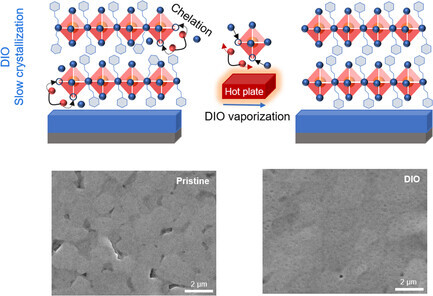Alkyl Additive-Mediated Growth of Two-Dimensional Tin Halide Perovskites for Efficient Charge Transport
- 저자
- Youjin Reo*, Taewan Roh, Taesu Choi, Geonwoong Park, Soohwan Yoo, Hyeyeon Jung, Ao Liu, Huihui Zhu*, Yong-Young Noh*
- 저널명
- Small Structures, 2500285, 6, 11 (2025)
- 년도
- 2025
- Link
- https://doi.org/10.1002/sstr.202500285 265회 연결
[Abstract]
Solution-processed two-dimensional (2D) tin (Sn2+)-halide perovskites have achieved great milestones in (opto)electronic devices. The fabrication of high-quality 2D Sn2+-halide perovskite films has remained a difficult challenge due to the Lewis acidity of Sn2+ and its rapid crystallization. Herein, incorporating an alkyl additive, 1,8-diiodooctane (DIO), to mediate growth of 2D Sn2+-halide perovskites by chelating with tin-iodide [SnI6]4− inorganic octahedral cage at the intermediate iodide vacancies is suggested. The chelation of DIO and 2D Sn2+-halide perovskites promotes deceleration of film crystallization, producing high-quality films with homogeneous connection of lattice aligned parallel to the substrates. The optimized DIO-incorporated 2D Sn2+-halide perovskite transistors and phototransistors demonstrate more than twofolds the field-effect mobility compared to pristine devices, enhanced operational stability, and optoelectronic conversion ability. The incorporation of DIO facilitates the optimal growth of homogeneous 2D Sn2+-halide perovskite films for emerging halide perovskite-based (opto)electronics.
